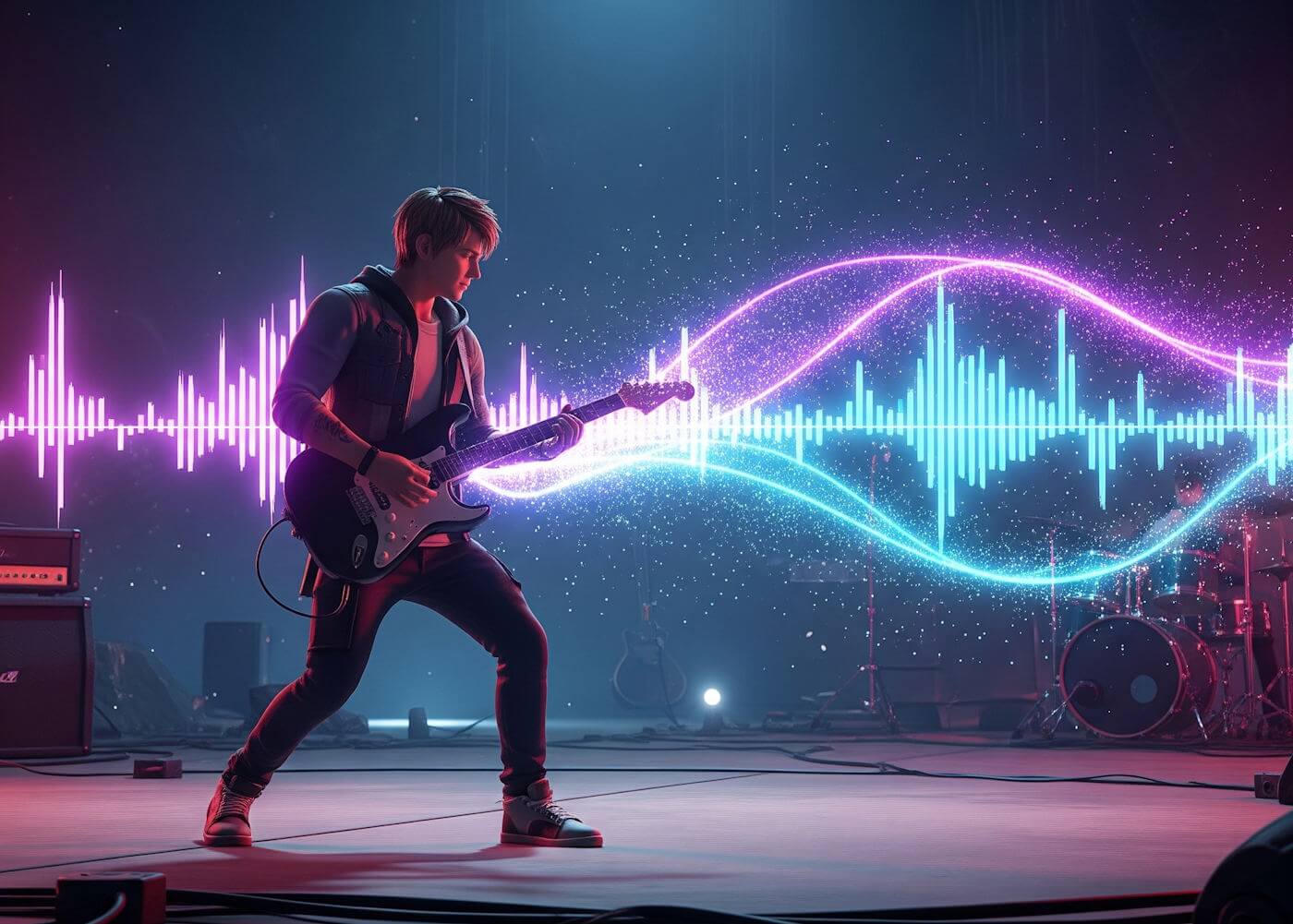Interactive Sound: How Music Responds to Your Actions in Games
Introduction to Interactive Sound
In the realm of video games, audio elements have evolved beyond the role of simple background noise, transforming into dynamic components that significantly enhance the overall gaming experience. This intricate aspect of sound design, often referred to as interactive sound, plays a crucial role in fostering player engagement and immersing them in the game world. Unlike traditional media, where sound can often be a static complement to visuals, interactive sound adapts and responds to players’ actions in real-time, creating a more personalized gaming journey.
The importance of sound design in interactive environments cannot be overstated. It serves to evoke emotional responses, guide player actions, and even convey narrative elements. For instance, the subtle changes in musical composition upon entering a new area or the heightened sound effects during an intense encounter can drastically alter a player’s emotional state. This psychological effect is paramount, as research indicates that sound can influence mood, decision-making, and even performance within the game.
Furthermore, interactive sound facilitates a deeper connection between the player and the game world. The synergy between visuals and audio creates a multi-sensory experience where players feel more involved in the storyline and gameplay mechanics. The responsiveness of sound allows for a nuanced interaction; when a player undertakes certain actions, the corresponding audio clues reinforce the weight of their choices, enhancing the reality of their engagement.
As the industry continues to mature, the development of tools and technologies for creating adaptive audio landscapes becomes increasingly vital. Audio designers are tasked with crafting complex soundscapes that dynamically shift based on the player’s behavior, ensuring that each gaming session is unique. This innovative approach denotes a significant leap toward holistic sound exploration where every beep, melody, and sound effect contributes meaningfully to the player’s immersive experience.
The Evolution of Sound in Gaming
The journey of sound in gaming is as vast and varied as the games themselves. In the early days of video games, sound was largely limited to simple 8-bit bleeps and chimes, primarily created using rudimentary synthesis techniques. These simplistic audio elements served more as cues or alerts rather than components that enhanced the overall gaming experience. Titles like “Pong” and “Space Invaders” exemplified this era, where beeps announced scoring and explosions, captivating players despite their technical limitations.
As technology progressed, so too did the complexity of sound in video games. The introduction of 16-bit consoles like the Super Nintendo and Sega Genesis marked a significant leap forward. These systems allowed for richer audio experiences, incorporating digitized sounds and more varied music compositions. Game developers began to appreciate the importance of sound design, leveraging MIDI formats to produce intricate musical scores that could adjust to gameplay. Iconic games such as “The Legend of Zelda: A Link to the Past” showcased these advancements, with sweeping orchestral scores that elevated the gameplay and engaged players on an emotional level.
The evolution continued into the late 1990s and early 2000s with the advent of CD-ROM technology, which brought about fully orchestrated soundtracks and voice acting. Titles like “Final Fantasy VII” not only pushed technological boundaries but also emphasized how sound could tell stories and evoke feelings. The industry began to recognize the power of audio as an essential narrative mechanism, paving the way for immersive soundscapes that interacted dynamically with gameplay. Today’s games utilize advanced audio technologies, including adaptive audio systems and spatial sound, further enriching the player experience. Such innovations illustrate the profound impact that sound technology has had on game design and player immersion, laying the groundwork for future advancements.
Understanding Reactive Music Systems
Reactive music systems are an innovative approach to audio design in gaming, allowing the music to change dynamically based on player actions and game events. These systems are fundamentally built to enhance immersion and engagement by ensuring that the soundscape evolves in harmony with player interactions. At the heart of reactive music is the concept of adaptive music, where compositions can transition seamlessly between different musical themes or motifs depending on various parameters, such as player performance or the current state of the game.
One prominent example of reactive music systems can be observed in the “Halo” series. The game’s soundtrack is composed in layers, with different musical elements activated based on the intensity of the gameplay. When players engage in combat, the music shifts to a more urgent and energetic tone, heightening the sense of tension and excitement. Conversely, during exploration phases, the background score may transition to softer melodies, allowing for an overall soothing experience. This fluidity in music composition showcases the potential of adaptive soundscapes in game environments.
Another notable implementation of this technology is found in “The Legend of Zelda: Breath of the Wild.” In this game, music responds not only to player actions but also to the surrounding environment. For instance, as players approach a specific location or encounter different weather conditions, the soundtrack subtly adapts, amplifying the atmosphere and drawing players deeper into the game’s world. Such procedural audio techniques allow for a unique aural experience that keeps each player’s journey distinct.
Overall, reactive music systems enrich the gaming experience by aligning auditory feedback with gameplay dynamics. This ensures that players remain engaged and connected to their virtual surroundings, highlighting the significance of enhancing emotional responses through audio. The evolution of such systems marks a step forward in gaming audio design, paving the way for even more immersive interactions in future titles.
The Role of Sound Designers and Composers
In the realm of interactive sound within video games, sound designers and composers play crucial and collaborative roles that significantly enhance the player experience. Sound designers are responsible for creating the auditory environment of a game, including sound effects, ambient sounds, and the overall sonic texture. They meticulously craft sounds that respond to player actions, ensuring that the auditory feedback aligns seamlessly with gameplay mechanics. This dynamic interaction is vital for immersion, as it helps in cueing players by providing immediate and contextual responses to their actions.
Composers, on the other hand, focus on the musical aspects of a game. They compose scores that can adapt to in-game events, a process known as adaptive or dynamic scoring. This approach allows the music to evolve based on the player’s progress, emotional state, or specific actions taken during gameplay. For example, the intensity of the score may escalate during high-stakes moments, directly influencing player engagement levels. The collaboration between sound designers and composers is essential, as soundscapes and musical scores must be finely tuned to work harmoniously together, ensuring a cohesive audio experience that complements the visual elements of the game.
However, the integration of sound into gameplay also presents considerable challenges. One primary obstacle is the need for real-time responsiveness; sounds must adapt seamlessly and instantaneously to player choices without feeling disjointed or artificial. Additionally, sound designers and composers must work within the constraints of technology and hardware limitations, which often dictate the richness of the audio experience that can be achieved. Addressing these challenges requires a deep understanding of both the technical aspects of sound production and the artistic vision of the game. By overcoming these hurdles, sound designers and composers contribute to creating a uniquely engaging and interactive sound environment that significantly enhances the overall gaming experience.
Case Studies: Games That Utilize Interactive Sound
Interactive sound design significantly enhances the gaming experience by creating an immersive atmosphere and establishing an emotional connection with players. Several notable titles exemplify this innovative approach, effectively integrating interactive sound into their gameplay mechanics. Among these, ‘Shadow of the Colossus,’ ‘Journey,’ and ‘The Legend of Zelda: Breath of the Wild’ stand out as prime examples of how music responds dynamically to player actions.
‘Shadow of the Colossus’ is renowned for its hauntingly beautiful score, composed by Kow Otani. The game utilizes a technique called adaptive music, where the score intensifies during key moments of the gameplay, such as boss battles against colossal beings. As players engage physically and emotionally with these monumental opponents, the music shifts from serene melodies to sweeping orchestral crescendos, mirroring the tension and excitement of the encounter. This seamless interaction between sound and gameplay not only amplifies the emotional weight of the experience but also serves as an audible cue, enhancing players’ positioning and strategies throughout the game.
‘Journey,’ developed by Thatgamecompany, employs a unique approach to interactive sound. The game features a persistent musical score that evolves in response to the player’s actions and interactions with other players. The music is not only a backdrop but an integral part of the storytelling, where players can engage with their environment and each other through subtle musical cues. This interactive sound design fosters a profound sense of connection, as players can contribute to a rich tapestry of sound through their movements and choices, resulting in a shared and meaningful experience.
Similarly, ‘The Legend of Zelda: Breath of the Wild’ showcases a masterful implementation of interactive sound. The game introduces a dynamic music system that reacts to various in-game scenarios, such as environmental changes and combat situations. As players explore the vast open world of Hyrule, the soundtrack transitions between peaceful melodies while wandering and energetic tunes during confrontations. This fluidity not only accentuates the thrill of exploration but also enriches the overall atmosphere, solidifying sound as a crucial component within the fabric of the gameplay experience.
The Emotional Impact of Interactive Sound
The realm of interactive sound within video games plays a pivotal role in shaping player emotions and enriching storytelling. Game developers leverage soundscapes strategically to forge deeper connections with players, enhancing their immersive experiences. Research in psychology highlights the powerful ability of music to evoke an array of emotions, making it an integral element in the design of interactive environments.
Various studies have demonstrated that certain musical elements can trigger specific emotional responses. For instance, a fast-paced melody may induce excitement, while a slow, melancholic tune can evoke feelings of sadness or nostalgia. In interactive games, sound often adapts dynamically, reflecting player actions and decisions. This correspondence between the player’s behavior and sound output can create tension or relief based on in-game events, allowing players to feel more aligned with the narrative.
The use of sound can transform gameplay moments into memorable experiences. For instance, a sudden shift in music during a climactic battle can amplify the stakes, making players more invested in the outcome. This synergy between sound and visual elements ensures that players experience heightened emotional engagement, prompting them to relate personally to the story unfolding before them.
Moreover, interactive sound contributes to character development and world-building. By incorporating thematic scores that evolve alongside character arcs, developers can deepen the player’s emotional attachment to the characters and the game’s world. Sound design that changes based on player choices can not only enhance narrative depth but also encourage exploration and experimentation, leading to uniquely emotional journeys for each player.
In conclusion, the emotional grip of interactive sound in video games cannot be overstated. By utilizing music and sound design effectively, developers can create profound emotional connections, significantly enhancing both the storytelling and overall gaming experience.
Future Trends in Interactive Sound Design
The evolving landscape of interactive sound design in gaming is significantly influenced by advancements in artificial intelligence (AI) and machine learning. These cutting-edge technologies hold the potential to enhance audio experiences, making them more personalized and responsive to player actions. As games increasingly strive for immersion, the role of sound will become crucial in creating a more engaging environment.
AI algorithms can analyze player behavior in real-time, adapting the audio landscape to reflect individual gaming styles and preferences. For instance, as players engage with different environments or challenges, AI could dynamically modify soundscapes, adjusting everything from background music to sound effects. This adaptability ensures that players are not only entertained but also feel a deeper connection to the game, as the audio evolves in tandem with their actions.
Moreover, machine learning can enable the creation of more intricate sound models that respond to actions in a nuanced way. Instead of pre-made sound loops, developers might implement procedural audio generation, where sounds are crafted on-the-fly based on in-game scenarios. This allows for an infinite variety of audio responses, enriching the gameplay experience. For example, the sounds of footsteps or environmental elements would change according to character movement or interactions, adding a layer of realism.
As these technologies continue to progress, we can anticipate more innovative uses of sound in gaming, enhancing storytelling and gameplay. Well-designed interactive sound will not only elevate the gaming experience but also attract diverse audiences. The fusion of AI and gaming represents a frontier where sound becomes an integral narrative device, offering experiences tailored to individual player journeys. Ultimately, the future of interactive sound design is one of limitless possibilities, promising a more engaging and immersive world for gamers worldwide.
Challenges in Creating Interactive Sound
The design of interactive sound in gaming is an intricate process that marries technology with artistry. One of the primary challenges in achieving effective interactive audio lies in the limitations of current technology. Although advancements have been made in sound engines and audio processing, many systems are still constrained by hardware capabilities and software compatibility. The dynamic nature of interactive sound requires real-time audio rendering, which can be demanding on both CPU and memory resources, especially in expansive gaming environments where multiple sound events can occur simultaneously.
Another significant hurdle faced by sound designers is the balance between audio complexity and performance. Developers must craft soundscapes that are rich and immersive without overloading the system. This involves making critical decisions about which sounds are essential to enhance gameplay while ensuring that the audio does not detract from the overall experience. Too many layers of sound can lead to a cluttered auditory environment that confuses players, whereas minimal sounds may fail to engage them effectively. Finding that sweet spot is crucial for delivering an engaging user experience.
Lastly, the quest for a seamless audio experience presents its own set of challenges. Achieving synchronization between audio cues and player actions is vital for immersion. Any delay or mismatch can break the player’s connection to the game, resulting in an unsatisfactory experience. Developers are constantly exploring solutions to reduce latency and improve responsiveness, yet this remains an ongoing struggle in the industry. The integration of adaptive sound design techniques, which dynamically modify audio content based on player interactions, is one way to enhance this experience. However, this leads to further complexities in managing audio assets and maintaining performance, underscoring the multifaceted challenges faced by those tasked with creating interactive sound in games.
Conclusion: The Importance of Sound in Gaming
In the landscape of modern gaming, sound stands as a pillar of immersive and interactive experiences. Throughout this blog post, we have explored how music not only accompanies gameplay but also reacts dynamically to players’ actions, creating a deeply engaging and responsive environment. The role of sound in gaming extends beyond mere auditory accompaniment; it serves as a critical element that enhances player interaction, emotional engagement, and overall enjoyment.
Interactive sound design enriches the narrative experience by providing players with auditory cues that react to their decisions and achievements. Such elements foster a sense of agency, allowing players to feel as though their actions have tangible consequences within the game world. This dynamic interplay between sound and gameplay fosters a richer experience, blurring the lines between player and character and making them feel more connected to the story being told.
Moreover, the effective integration of sound into video games is increasingly recognized as being on par with visuals in terms of importance. While high-definition graphics have always dazzled audiences, it is often the intricate soundscapes that linger in players’ memories long after gameplay has ended. The emotional responses elicited by well-crafted music and sound effects can significantly influence the way players perceive and engage with the narrative, making sound an indispensable aspect of game design.
In summary, the importance of interactive sound in gaming cannot be overstated. It amplifies the emotional weight of a game’s narrative, enhances player immersion, and ultimately contributes to a unique entertainment experience. As the gaming industry evolves, prioritizing sound design will continue to play a crucial role in shaping the future of interactive storytelling and gameplay mechanics.







